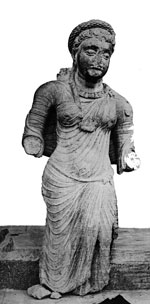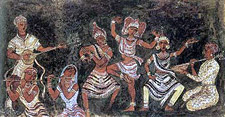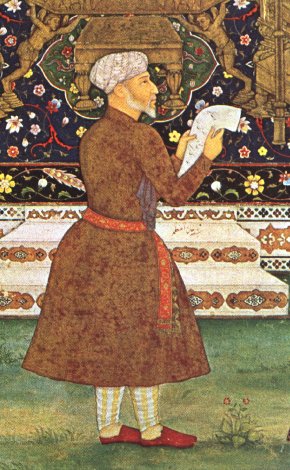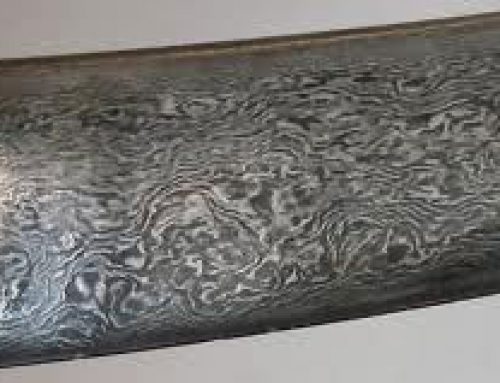
Ancient Indian clothing: A woman wearing a long tunic – Mathura, 100s AD
Ancient Indian clothing: the cotton dhoti
People in India wore mostly cotton clothing. India was the first place where people grew cotton, even as early as 5000 BC in the Stone Age. Men wore dhoti, a cloth wrapped around their waists and knotted at the back. Some men also wore turbans on their heads; many men wore man-buns and kept their beards short or shaved. Men kept on dressing like this for thousands of years.
History of cotton
Stone Age India
More ancient India articles
What did women wear in ancient India?
Women wore short skirts, just from the waist to the knees, and a cloth head wrap, maybe to keep the sun off. Women wore necklaces and bracelets, too, made of stone and shell beads, and later of bronze and silver and gold.
More about Indian beads
What is bronze?
Vedic Indian clothing
By the Vedic period, women wore cloth wrapped and pinned around themselves much like the outfits of Iranian women or Greek women. Some women wore skirts wrapped and pleated around their waists and knotted in front, with a separate piece of fabric for a shawl or veil, and a tight shirt underneath.
Women in West Asia
Women in ancient Greece
What is a sari?

Women in the Guptan empire wearing saris
By the Guptan period in late antiquity, about 500 AD, many women had shifted to wearing one very long piece of cloth called a sari (still with the tight shirt underneath), that they wrapped around themselves in different ways. The word sari comes from a Sanskrit word that just means cloth.
The Vedas are the first written stories that mention saris, about 600 BC. Rich women wore saris made of silk from China, but most women wore cotton saris. Today, many people think of saris as the main type of Indian clothing.
What is silk?
More about the Gupta period
How did women wear their sari?
There were many different ways of draping saris, depending on how rich you were and where you lived in India. To dress up, women wore their sari like skirts with a top part thrown over their shoulder or worn over their heads as a veil. Working women often pulled their sari up between their legs to make a sort of pants.
Women who were fighting with the army tucked in the top part of the sari in the back, to free up their arms for fighting. Most saris were five or six yards long, although some saris were nine yards. Younger women generally wore brightly colored saris, but widows and other women in mourning for someone who had died wore only white saris.
Indian clothing: How to put on a sari
Sewing needles and embroidery
At the same time, the first sharp steel needles reached India from China, and as a result rich men and women began to wear stitched clothing fitted tightly to their bodies, with lots of embroidery. But most people still wore saris. Often people wore embroidered saris over their tight shirts.
Invention of sewing needles
Clothing in ancient China

Both men and women started wearing Iranian pants and tunics
Churidar or salwar kameez
With the Islamic invasions around 1000 AD, Iranian fashions in clothing entered India. Ancient Indian clothing became medieval Indian clothing. Both women and men started to sometimes wear trousers with long tunics over them down to their knees, called churidar or salwar kameez. Women generally wore churidar with a long veil or scarf over it.These fashions became popular, especially in northern India. But they never replaced the sari or the dhoti.
Islamic invasion of India
Indian women who could afford it usually wore a lot of silver or gold jewelry, especially earrings and nose-rings. Sometimes they also put a spot of red on their foreheads called a bindi (BINN-dee) as a decoration.
What did Indian children wear?
Babies in India often wore nothing or just a cloth wrapped around them as a diaper. Little kids usually wore a plain tunic down to their knees – a long shirt – if they wore anything. Older kids dressed like their parents. However, girls generally did not wear sarees until they were married, or at least until they were older teenagers. Before that, they wore tunics and trousers (salwar kameez) in northern India or skirts with tops (pattu langa) in southern India.
Did you find out what you wanted to know about ancient Indian clothing? Do you have more questions? Let us know in the comments!
Learn by doing: practice putting on a sari or a dhoti
More about Indian cotton
And more about silk
More about Ancient India
Bibliography and further reading about Indian clothing:
Traditional Fashions from India Paper Dolls, by Ming-Ju Sun (2001). Written for kids. Includes two dolls and sixteen costumes.
India and Sri Lanka (Cultures and Costumes), by Conor Kilgallon (2002). Easy reading.
Eyewitness India, by Manini Chatterjee (2002). Written for kids.
Ancient India, by Virginia Schomp (2005). Written for teens. Very good for reports.
The Sari, by Mukulika Banerjee and Daniel Miller (2004). For adults, a great discussion of what it’s really like to wear a sari.





Thank you, could you add info about clothing in different social classes?
This is so cool! can you make one about the making of the clothing too? I would love to see how they made it.
I could not find anywhere else on internet about Ancient Indian womans wearing short skirts except this website.
Here’s a good source: https://books.google.com/books?id=uRMGDmdE9FkC&pg=PA151&dq=indian+clothing+harappan&hl=en&sa=X&ved=2ahUKEwjGkIm_m7fkAhUow1kKHTXCCK0Q6AEwAHoECAAQAg#v=onepage&q=indian%20clothing%20harappan&f=false
and here’s another: https://books.google.com/books?id=H3lUIIYxWkEC&pg=PA174&dq=women%27s+clothing+harappan&hl=en&sa=X&ved=2ahUKEwi8pej6m7fkAhVypVkKHdzMCmEQ6AEwAnoECAIQAg#v=onepage&q=women's%20clothing%20harappan&f=false
The books are about Harrapan/Indus Valley civilization and not medieval India! you do realize Indus Valley continued until 1500BCE, 3519 Years ago??
The ‘Long Tunic’ from 100 AD is called ‘Saree’ worn today by every woman, it originates from Indus Valley Civ, around 3000 BCE. Clearly your Professor degrees are fake since you can’t differentiate a Short skirt with something else.
You are being fed misinformation by Hindu nationalists; there is no evidence of women wearing saris in the Bronze Age. And many women in India today do not wear a sari either.
am real name is Benny
Interesting article. Can you please share if you have any article on how the sales of clothing have evolved in India.. means from home trading to boutiques/ apparel stores now
Sorry, but we do have an article about British colonization and how it destroyed India’s clothing trade in the 1700s and 1800s… https://quatr.us/economy/spices-cotton-mughal-indian-economy.htm
great article! Can you explain the differences between what the rich wore and what the poor wore in ancient Japan? Thanks.
Hi! Sadly, we haven’t written that article yet – I’ll try to get to it soon. But you can get a good idea from our article on ancient Chinese clothing: . Basically poor people wore mostly hemp, and after the 1200s, cotton, while rich people wore more silk. They all wore tunics, with women usually wearing longer tunics than men, and rich people often wearing more than one tunic, tunics with embroidery, and tunics dyed in more expensive colors. Rich people could also wear more leather and fur.
https://quatr.us/china/ancient-chinese-clothing.htm
Imported from China itseems???
Well, people in India did eventually start to wear silk imported from China. But people in China started to grow Indian cotton, and from the Middle Ages on, most of the clothing people wore in China was made of Indian cotton. Then in the 1800s they started to grow American cotton instead – that’s what people in China wear now.
I liked this it was helpful I will make sure to use it in the future.
Thanks! If you have a school website or a teacher website or anything, we’d love to have a link from it!
What was the publication date I couldn’t seem to find it.
It’s in the “Cite this” box right under the article (and above this comment section). There are two dates: the second one is today’s date and the first one is the date that the article was published.
COOL!
Saree is the original clothing for women.. only scientists made of a theory that it started at some point. Why does everyone fall for scientists little theory. They are just guessing!!!!!!!!
Short skirt means that they hiked the saree up for doing physical work.
Indian culture is perfect. Everyone used to be vegetarian. Everyone practices moral principles and no slaughterhouse. Only Europeans messed things up. Thank you.
It’s often true that when you look into something, really checking, you find out that what seemed obviously true really was something different. That’s how it is with sarees. Yes, today women hike up their sarees for physical work. But long ago, women in India wore short shirts.
You might be interested in our article about what Indian people ate before they were vegetarians, too: https://quatr.us/india/indian-food-history-ancient.htm
I completely agree!
I love the info you wrote, I have humanities assignment soon.
How do you know all this?
I took classes in graduate school, and I read a lot of books and articles! You can find some of those articles listed in the bibliography for this article.
can you add some detail on the children’s clothing from ancient India please? it would be really helpful 9even though your article is already great!)
That’s a great idea! While I’m working on it, I’ll just say that babies often wore nothing or just a cloth wrapped around them as a diaper. Little kids usually wore a plain tunic down to their knees – a long shirt – if they wore anything. Older kids dressed like their parents, but girls generally did not wear sarees until they were married, or at least until they were older teenagers. Before that, they wore tunics and trousers (salwar kameez) in northern India or skirts with tops (pattu langa) in southern India.
This is really helpful! Did you write any more websites about ancient India? I would love to read them.
Sure! We have lots of articles about ancient India. You’ll find them here: https://quatr.us/history-india-stone-age-today
why you do dis
Why do I write articles? I like writing, and I like history, and I want to help people know stuff!
Wow, this was really helpful thanks! By the way, I am doing a test on India so I hope I get an A+
I hope you do too! Fingers crossed!
This was really helpful could you add a little more on mens
If you ask a specific question, I’ll try to answer it: “a little more” is pretty vague.
i am going to tell my friends about this so you will be more popular
Thank you! I’d love for you to tell your teachers, too!
this is a nice website
do u think u can make a something like this telling types of jewelry and clothing
I think this already describes different types of clothing? For more about jewelry, you might want to read about Indian glass beads (https://quatr.us/india/ancient-indian-economy.htm) and pearls (https://quatr.us/clothing/pearl-diving-history-pearls.htm).
You are very helpful
I got most of my info for my project from you!
Do not worry, im not plagiarizing.
I’m happy to hear it! Please don’t hesitate to ask if you have any questions as you write up your report.
Indian women from the north drape there saris over one shoulder the women from the self wear it over the other shoulder which is which
I think there’s a lot more variation than that in how women wear their saris. But also there have been a lot of changes over time. This article is about how women wore saris more than a thousand years ago.
Hey that pretty nice
Great! please add more about clothing.
The whole article is about clothing. What in particular did you want to know? Can you ask it in the form of a question please?